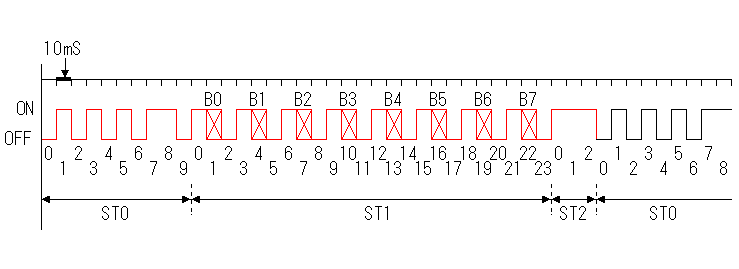Time Chart for Transmitter

|
I will show the time chart of the control code in the figure above. This composition is the composition which I contrived and is not standard composition. The switching time of each bit is 10 milliseconds. The signal to transmit from the transmitter is composed of three blocks. In the program, three blocks are managed by transmission status (TX_STATUS). ST0, ST1, ST2 show transmission status with the figure above. A bit in each block is managed by sub status (TX_SUBSTATUS). The figure which is written under the signal in the figure above shows sub status. A preamble signal is transmitted in the first block. This signal repeats ON/OFF and is used to confirm that it is a signal from the normally transmitter at the receiver. Also, it uses to decide the detection position of the bit at the receiver. At the end of the preamble signal, it is shown in the ON condition which was continued twice and the OFF condition after that. The following block is the block which sends a control code. Each bit of the control code is put in by the ON signal and the OFF signal. With this, even if all bits of the control code are "1"(ON), the OFF condition always exists. Also, the ON condition always exists even if all the bits of the control code are "0"(OFF). Wrong detection at the receiver is prevented by this. Moreover, because it uses 3 bits to send 1 bit, the detection of the signal which repeats ON/OFF can be prevented. In the last, it is a code ending block. It is in the ON condition which was continued three times. The ON condition which was continued three times exists only in this block. In case of continuously the electric wave, the ON condition which was continued three times exists. However, the following in this block is the block of the preamble again. So, the detection which was wrong with the continuously electric wave isn't done. Above-mentioned three blocks are repeatedly transmitted. The receiver doesn't always receive the electric wave which was transmitted from the transmitter from the beginning. The receiver checks a preamble signal when it receives an electric wave. The receiver judges a preamble signal when receiving the signal which changes as ON-OFF-ON. Such a change doesn't exist in the control code block and the code ending block. When beginning to receive from the control code block, it skips the control code and the ending code and it catches a preamble signal. |